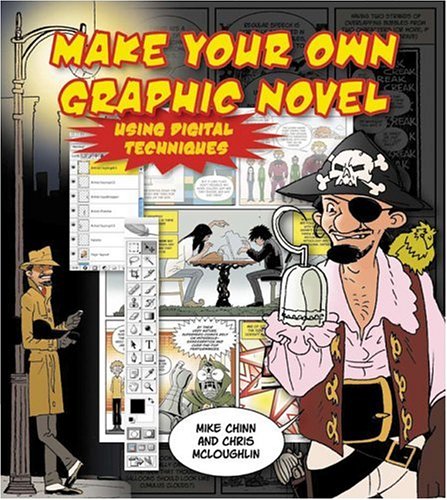
Dr. Darrell Starkwood looks to strike back at Dr. Miller.I have written a really cool back-story for Darrel Starkwood, I'm just not sure it will be delivered fully for everyone to understand, but it's there anyhow. I'm not sure if people like Starkwood or what, but I like writing for him, and winding him up.
As our characters get further away from him, you'd have to think his influence on them would decrease - we'll have to see if that happens or not.
Graphic novel news
Sara Quin loves reading, wants you to love it too
AfterEllen.com
Lindsey Byrnes

Last week, Sara Quin appeared on the CBC's Canada Reads, a televised program in which panelists present a book they feel is the most important novel to come from/be about Canada. Sara chose Essex County, a graphic novel by Jeff Lemire. She had to make her case for the book, but the odds were stacked against her from the beginning, as the other panelists (Ali Velshi, Debbie Travis, Georges Laraque and Lorne Cardinal) couldn't see past the fact that it was a graphic novel, thus having fewer words.Click to read more.
AE: How did you decide on Essex County for your pick?
SQ: It was on the short list and it was something that I had already read and loved. thought it would be a terrific way to both defend a book I admired, but also a genre I respect greatly.
AE: Was part of your decision to include a graphic novel because you wanted to push that boundary a little bit; challenge people to consider the art form?
SQ: I absolutely hoped that my defense and the exposure around the show would push those people who hadn't read a graphic novel before, to consider it. I also like being the underdog.
AE: How did you get into graphic novels?
SQ: I think it was a natural evolution from comic books to more long form comics — graphic novels/memoir/journalism — and eventually it took over my life.
"True Blood: All Together Now"
Posted by Samantha Fox
Fangoria.com

The TRUE BLOOD graphic novel ALL TOGETHER NOW (IDW; $24.99) collects the first six-issue series of TRUE BLOOD comic books, inspired, of course, by the hit HBO show and Charlaine Harris books. ALL TOGETHER NOW takes place at Merlotte’s during a thunderstorm. Characters Sookie, Jason, Eric, Tara, Lafayette and Sam, as well as a few locals, are hanging out inside, waiting out the bad weather. When the psychically “gifted” Sookie approaches a dining patron, she realizes it’s really an “Imp Shaloop” named Ted, who has numerous tentacles and the ability to crush (and kill) her and her friends. Shortly after Sookie’s beau Bill arrives, he quickly gets bitch-slapped by the beast.Click to read more.
Sookie is able to give him strength by allowing Bill to suck her blood, but unfortunately, the rest of her pals aren’t vampires–she won’t be able to help them if they get hurt as well. The octobeast decides to play a game with the hostages at Merlotte’s in exchange for allowing them to keep their lives–they have to reveal their deepest, darkest, secrets; painful memories that they had never shared with anyone before. Sookie goes first, and tells a story of when she was a child. [SPOILER ALERT] Being able to read minds, she figured out that her parents were somewhat frightened of her, and she resented that. One day when Sookie and her brother were dropped off at their grandmother’s house, Sookie confronted her mom, told her she hated her and ran away. That night, her parents drowned in a flood. Tara tells her story next as a diversion so Sam can attack the Imp Shaloop. He fails. The rest of the gang reveals their secrets, and it appears that the strange beast is somehow feeding off of their pain.
Developed by TRUE BLOOD creator Alan Ball and show writers Elisabeth Finch and Kate Barrow, ALL TOGETHER NOW was co-written by David Tischman and Mariah Huehner. It features illustrations by David Messina, J. Scott Campbell, Joe Corroney and Andrew Currie. Although the story is somewhat predictable, it’s not too hard to follow, especially if you’re not a huge TRUE BLOOD fan. The graphics are realistic, but almost too much so. Rather than having a classic comic strip feel, the book appears as if images from the show were cartoonified in Photoshop and then printed. The bonus photo gallery is nothing to write home about either; mostly images that resemble fan art that one would find in a TRUE BLOOD fan blog or on deviantART.com. Overall, ALL TOGETHER NOW is enjoyable, but unless you’re a die-hard Trubie, you may have buyer’s remorse.
Lee Bermejo to write and draw Batman: Noel graphic novel
Robot 6 comicbookresources.com
Kevin Melrose

The first news to emerge from the ComicsPRO annual meeting in Dallas is that Lee Bermejo, the critically acclaimed artist of Joker and Lex Luthor: Man of Steel, will write and draw a Batman graphic novel for DC Comics.Click to read more.
Titled Batman: Noel, the holiday-themed book will mark Bermejo’s comics-writing debut. It’s edited by Mark Chiarello, DC’s vice president of art direction & design.
“I’m totally excited by this project, and not only because Lee Bermejo is such an astounding artist,” Chiarello tells the DC Universe blog The Source. “Sure, the work he’s done in the past (Joker OGN, Wednesday Comics) has been pretty brilliant and I’d expect nothing less from Lee, but the added bonus of Batman: Noel being drawn and written by Lee is extra cool. In other words, I knew Lee could deliver the goods artistically, but I never knew he was also this great of a writer!”
No released date was mentioned.


































